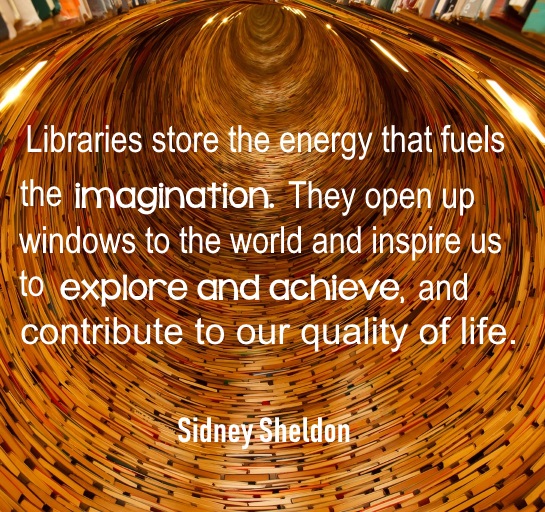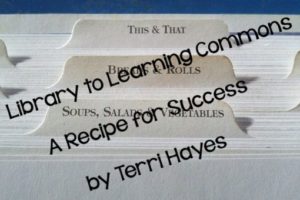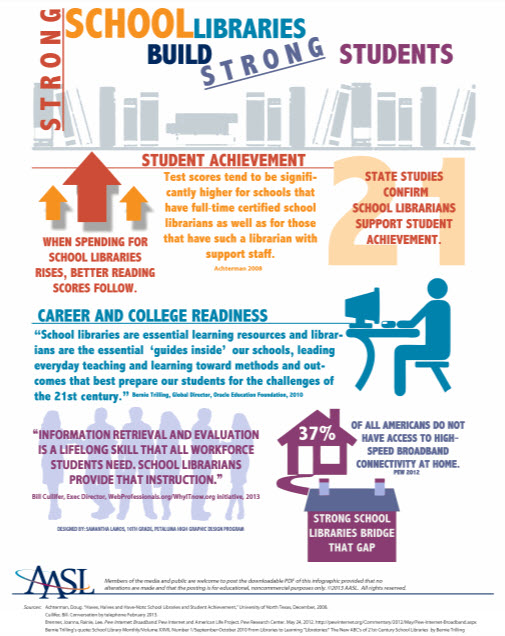
What makes the difference, or is there any? Enjoy this brief slideshow I put together for a teacher-librarian course. My sister (who had no choice but to watch) calls the last slide the punch line.

Kitchens need recipes, right? Here’s are some for a successful LLC:

Like great food, I have always loved school libraries. They are as important today as they have ever been; however, the recipes for a successful school library program have changed. Loertscher, Koechlin and Zwaan describe the contemporary school library as a learning commons, “the hub of the school, where exemplary learning and teaching are showcased, where professional development, teaching and learning experimentation and action research happen.”[1] Teacher-librarians, once primarily managers of school resources, can become instructional leaders, supporting and collaborating with every teacher in the school, promoting inquiry-based learning and fostering a thriving reading culture.
Below are some of the ingredients:
A recipe to foster student collaboration and personalized learning
Flexible furnishings…virtual book clubs, book talks and author visits….performance spaces…[c]o-teaching…addition of iPads, iPods and eBooks, a breakout space from their regular classroom, or as a place to attend book clubs, literature circles and other literacy-based programs, and we have a rich resource for meeting individual learning needs.
A recipe to promote inquiry-based learning
…inquiry-based learning…cooperative planning of an inquiry activity integrated information skills instruction….
A recipe to promote staff collaboration
Collaboration, trust, relationships and respect are key components for school success.
A recipe to steward valuable time and resources
teacher-librarians can ensure that the school is purchasing resources that meet the needs of students…classroom library carts that can be rotated from classroom to classroom, virtual resources and databases
a feast of learning
However, it should be apparent from these recipes that the library-to-learning commons transformation involves more than flexible furnishings and a new coat of paint. In fact, it is great staff, not great stuff, which is the hallmark of a thriving school library learning commons.
 Terri Hayes is a Canadian teacher-libraian and administrator. Bon Appetit!
Terri Hayes is a Canadian teacher-libraian and administrator. Bon Appetit!
https://www.edcan.ca/articles/library-to-learning-commons/

Besides recipes, kitchens need good, fresh foods. A colleague generously shares her insights on how to grow a library.

The infographic below shows just why strong libraries are so critically important:

There are a couple more pages to this document with more explanation:

Advocating For School Library Programs – Report to Staff
by Barbara Allisen
Once upon a year…
Webster’s defines reading quite simply as making meaning from print; the action or skill of reading written or printed matter silently or aloud. As teachers we know the process of creating meaning from print is anything but simple. Not only that, the print medium of books has expanded to include screens of all sizes with blogs, posts, tweets, browsers, blogs, articles, documents, spreadsheets, infographics and more in a constant stream. Somedays, I think the words ‘Snapchat’ describe what’s happening in my brain.
Our goal, as a staff, is to help kids cope and make sense of this information explosion. The goal or focus of an exemplary library program is to: develop a love of literature and reading, and teach students to become independent, information literate, lifelong learners. (A Framework for School Library Programs in the 21st Century, School District #73 Kamloops/Thompson)
District #73 in Kamloops outlines 4 strands: LITERATURE, INFORMATION LITERACY, LEADERSHIP AND CURRICULUM SUPPORT, and LIBRARY MANAGEMENT. Our district has great resources too but this summary is helpful.
As staff, you each know best the ways you need support from me as teacher librarian. I’ve gleaned some of that from your requests, comments, and questions. Using that as a starting point, here are some of the plans for ways to develop the school library program and expand on ways to support you and the students.
–I’ll start with Library Management. First, is organizing the library into easy-to-find-and-use resources. Sometimes, these are in containers and sometimes, on a whole shelf. Bins, baskets, and holders will have words and relevant pictures. There are clipboards now hanging right behind the desk where you can jot down almost the minute you think of it resources you need we don’t have. These become priorities for budgets. Spaces will be arranged too, such as an interactive area, a presentation carpet, and a quiet-all-in-my own-world retreat. Any ideas on best-place for a digital area since the computer lab is being changed?
–In terms of Literature, collection and access are only part of the story. (pun humorously intended). There will be literacy activities including: displays, author visits, the Book Fair, participation in local events such as BookFest, Public Library Reading Challenge, Red Cedar awards, school events, and the library club.
–For Information Literacy, I want to tap into district resources for a K-7 continuum of digital citizenship and literacy goals. Together, I’d like to develop some joint activities. From talking with a couple of you we’ve come up with ideas such as students writing their own graphic stories, making an info page of the life-cycle of the chicks, and a comic of the salmon hatching process. These integrate so many areas of curriculum and literacy development.
–And that leads into the fourth strand of Leadership and Curriculum Support. I’m pretty familiar with the curriculum in kindergarten but remember, after grade 2 the kids are bigger than I am, so I haven’t strayed much into these classes. I will need to make a quick-and-easy summary of the rest of the grade levels. When you do those outlines for parents could you make me a copy? I’ll highlight the main topics and make an overall chart. We’ll go from there to work on some units and topics and organize what resources we’ve got and what we need.
A special interest project of mine is to create and collect Story Stones. Neuroscience is discovering the human brain is wired for story. Lisa Cron, the author of Wired for Story: The Writer’s Guide to Using Brain Science to Hook Readers from the Very First Sentence says: Opposable thumbs were a big step in human evolution, but…stories were too….[O]opposable thumbs help us hold on, but stories tell us what to hold on to. Stories are a way to teach and learn. “When you’re lost in a good story, it’s not arbitrary, it’s not pleasure for pleasure’s sake. It’s biological, it’s chemical, it’s a survival mechanism.” (http://wrvo.org/post/neuroscience-shows-brain-wired-story)
In a way, story stones date back from the very earliest of times. Maybe cave art is just the cave dwellers big screen of story stones. Stones combine hands-on with visual and auditory. It’s a highly versatile resource and very cost-effective. The idea first popped up from the site Happy Hooligans but just a glance at Etsy shows how popular and widely-used they are.

In the electronic-age, we risk losing what Einstein called even more powerful than knowledge. The Imagination. We may discover as Artificial Intelligence becomes increasingly more prevalent that Imagination is the most precious human ability. Story Stones are a way to tap into and grow the imagination.
I’m so excited to be back for another year. Who knows how much we will be able to do in a year. Plans often have their own ideas of how they will work and evolve. This is only the starting point and it’s open to change and input. We don’t know yet the end of the story for the upcoming year, but we can crack open the cover. Once upon a year…

How do you see your library? Is it the hub of the wheel? The heart of the school? Join me in this visualization of the library as THE BRAIN…

The Library as “Brain” — Engaging the Learning Brain
“We must use these principles to help us move away from the limiting metaphors of the past where we saw the school library as the “hub” or “heart” of a school; it is better thought of as the “brain” and the “nerve centre” of the school where learners gather in a “learning commons” built around inquiry, creativity and interconnected/interdependent communities….[L]learners will bypass us completely unless we become knowledgeable about new resources and new ways of building and disseminating knowledge. Even professional development and learning for teacher librarians needs to embrace new ways of building and sharing knowledge… such as movies (Moayeri, 2008) and immersive environments in Second Life (Kemp & Haycock, 2008).
(Towards a Transformative Pedagogy for School Libraries 2.0, Marlene Asselin, PhD and Ray Doiron, PhD, School Libraries Worldwide – Volume 14, Number 2, July 2008)
Library as the school brain, with messages to and from classrooms, connecting all the different parts. But just like the brain, there are the outer pathways AND all the inner ones with the vast complexity and diversity of neurons. In the case of the library, in addition to the rest of the school outside, again like the brain, think of all the books and other resources inside.
Science is revealing more and more about the brain. Some of the most exciting studies, to me at least, are on the subject of how the brain is neurologically wired for story. This seems especially fitting for libraries, as the greatest repository of stories we have!
MRI scans allow us to peek at the brain. As we listen to or read a story, our brains react in amazing ways. According to research in Spain, just reading a smell word lights up the smell parts of the brain.
“Subjects passively read odour-related words (‘garlic’, ‘cinnamon’, ‘jasmine’) and neutral language items. The odour-related terms elicited activation in the primary olfactory cortex, which include the piriform cortex and the amygdala. Our results suggest the activation of widely distributed cortical cell assemblies in the processing of olfactory words.”
(Neuroimage: Reading cinnamon activates olfactory brain regions, J. González, A. Barros-Loscertales, F. Pulvermüller, V. Meseguer, A. Sanjuán, V. Belloch, C. Avila, 2006 )
The same thing happens with touch words lighting up the parts of the brain involved with sensory processing.
“Using functional magnetic resonance imaging (fMRI) we show that texture-selective somatosensory cortex in the parietal operculum is activated when processing sentences containing textural metaphors….”
(Journal of Brain and Language: Metaphorically Feeling – Comprehending Textural Metaphors Activates Somatosensory Cortex, Simon Lacey, Randall Stilla, K. Sathian, , 2012)
Not only are language areas of the brain, primarily Wernicke’s area and Broca’s area, activated, so are the ones involved with the physical senses. That makes me wonder, “If sensory and action words trigger activity in the parts of the brain for senses and movement, do emotional words do that for their corresponding parts of the brain (or heart)? (Insert pause for Google searching.) …Hmm, I haven’t found that yet, but according to Canadian Professor Dr. Raymond Mar, from York University, who analysed 86 fMRI studies,
“[T]here was substantial overlap in the brain networks used to understand stories, and the networks used to navigate interactions with other individuals — in particular, interactions in which we’re trying to figure out the thoughts and feelings of others.”
(Buffer Social: The Science of Storytelling – What Listening to a Story Does to Our Brains, Leo Widrich, 2012)
This ability to build up in our own minds what’s going on in someone else’s is called “theory of mind,” and is stronger in those who read fiction. Wow, more stories = stronger minds.
“Dr. Oatley and Dr. Mar, in collaboration with several other scientists, reported in two studies, published in 2006 and 2009, that individuals who frequently read fiction seem to be better able to understand other people, empathize with them and see the world from their perspective. This relationship persisted even after the researchers accounted for the possibility that more empathetic individuals might prefer reading novels. “ (italics mine)
(Sunday Review: Your Brain on Fiction, Annie Murphy Paul, 2012)
Another excerpt I found particularly intriguing, given that I have spent more of my life with 5-yr olds than anyone else!
“A 2010 study by Dr. Mar found a similar result in preschool-age children: the more stories they had read to them, the keener their theory of mind — an effect that was also produced by watching movies but, curiously, not by watching television.”
(from Cognitive Development: Exposure to media and theory-of-mind development in preschoolers, Raymond A. Mar , Jennifer L. Tackett, Chris Moore, 2010, as reported in Sunday Review article above)
Sometimes, it really does seem as if everything old is new again. The power of stories has been with us from the time of cave-dwellers and new research is affirming what the wise elders have known all along.
Now, libraries have more than books for stories. There are recordings, videos, movies, and even parent volunteers and presenters. With internet connectivity as well as shelves, students can find stories in blogs, ebooks, social networks, Skype calls, YouTube, and more—anywhere.
To go back to the first quote, of the library as brain rather than heart, once again there’s new research. This time, it’s showing there are brain cells in the heart so, in a way, the heart is a sort of brain. Well, not exactly, but the heart does indeed have neurons.
“None of this means that the heart has a mind. It takes more than neurons, or even a system of neurons, to form a mind. A complex network of neurons can function like a computer chip, and no more has a mind than your laptop does.”
(Neurologica Blog: Brain Cells in the Heart? Steven Novella, 2013)
That really makes me chuckle! Isn’t that the aim of AI, computer chips with minds that think? So, Novella can’t use that argument. With all the emotion as well as information, no matter if we call the library the heart or the brain, it is functioning as both. The library is not just the experiences of others; as new research is showing, these experiences become our own.
And so, what does this mean for libraries? It means, libraries are up close and personal encounters of the learning and experiencing kind—in a new diversity of ways. How can we as Teacher Librarians harness the power of story and library and best connect our resources to student learning needs?